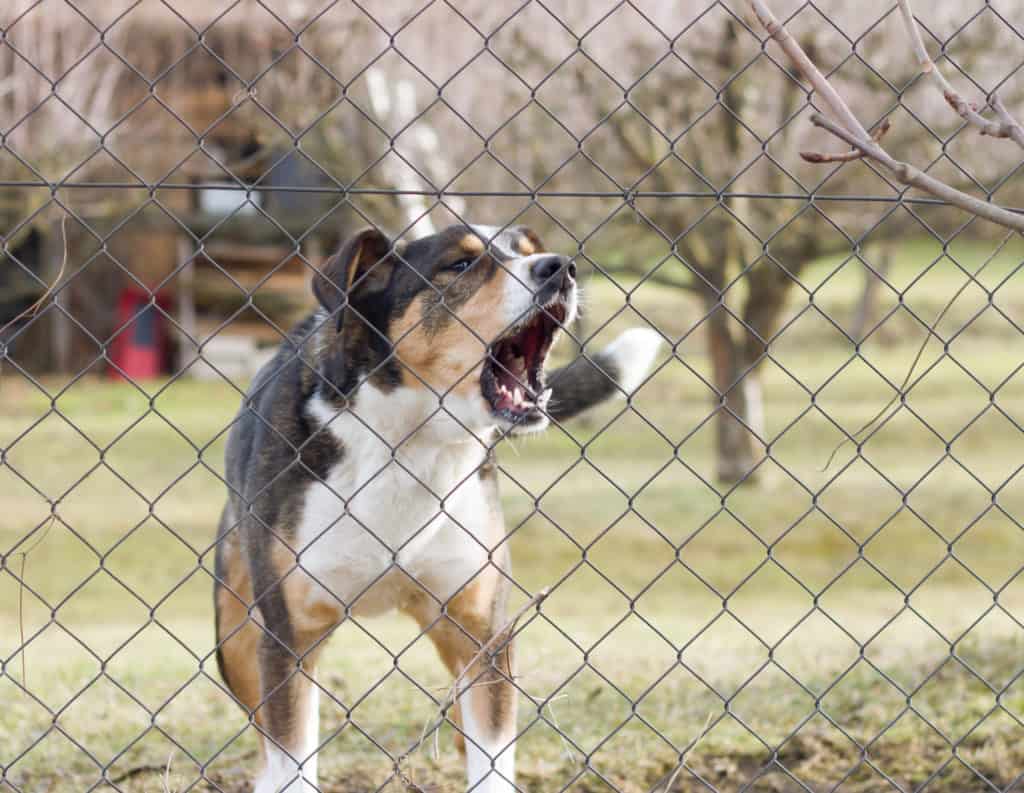Have you ever seen a dog at the end of its leash, barking and lunging at something passing by? Perhaps you’ve witnessed a dog charging back and forth behind the fence in its yard, arousal levels escalating rapidly as a passerby strolls past.
In many instances, these same dogs behave very differently as soon as they are off-leash, or are able to interact outside of the boundary of their yard. How is it that these barriers can create such a significant difference in the way that a dog interacts with a stimuli?
The concept of barrier frustration, or barrier aggression, is not a new one. Leash reactivity has been a major concern of many dog owners since people first started putting dogs on leashes and taking them out in public. Many times, leash reactivity is attributed to a lack of quality socialization during critical development periods in puppyhood; however, although this can certainly be a contributing factor, it is not always the case. Dogs displaying extreme behaviors behind walls or during movement restriction is a very common issue in many locations where physical boundaries are frequently used to control motion.
What is barrier frustration?
Although there are many definitions for frustration, one particular study on barrier frustration defines it as “an emotional response to the violation of a given expectation.” In this particular context, the given expectation is how a dog intended to engage with a stimuli, and the violation is the barrier preventing them from doing so.
Dogs are, by nature, physical communicators who gain information regarding the world around them by interacting with it. Oftentimes, olfaction is the primary driving force in attaining information, followed by hearing, sight, taste and touch. Although dogs have incredible noses and can smell things from far away, many dogs like to get close enough where they can pick up minuscule details about a focal object.
By preventing a dog from being able to engage with the world in the way that they need to satisfy their curiosity, fixation and frustration can occur. Since barriers limit movement, they also have implications for a dog’s safety. If a dog views a stimulus as a potential threat and is unable to make adequate distance, they may decide that aggressing is the only way to create distance between themself and the stimulus.
Ultimately, barrier frustration is typically referred to as being an extreme emotional response (typically accompanied by vocalizations, repetitive behaviors and lunging), occurring when a dog is unable to interact with a stimulus in the way that it naturally would if full movement was available.
Why does barrier frustration happen?
It is speculated that barrier frustration occurs due to a perceived loss of autonomy or an inability to reach a goal. In one study, it was actually found that total cortisol levels increased notably after episodes of barrier frustration. Vocalizing, which is a common behavior demonstrated during episodes of barrier frustration, was consistently tied to higher than average levels of cortisol released after the experience.
Cortisol is a hormone which is released after the body enters “fight or flight.” When the sympathetic nervous system communicates that there is a potential threat, cortisol is released to help the body remain alert until the threat passes.
When a dog becomes stressed because they cannot freely engage with their environment or move away from a perceived threat, their body initiates a stress response and they react accordingly. Although they will eventually calm down once the triggering stimulus passes, they will likely remain on high alert for the remainder of the time that their movement is being restricted by the barrier – and for a certain duration of time afterwards.
This is why people frequently notice that their dog’s leash reactivity becomes worse the longer they are out in public, and the more times which they are triggered to react. In instances where a dog is reacting behind a fence, owners often notice that their dog’s responses to people or dogs walking by their house occur more quickly and more extremely each time the dog reacts. Barrier frustration can quickly sensitize a dog to stimuli which would not have otherwise become triggering.
Is barrier frustration dangerous?
You may be thinking, “So, if I just get rid of physical barriers, my dog will stop reacting?”. Like many considerations in dog behavior, the answer is: it depends.
During the early stages of barrier frustration development – especially if the frustration is occurring due to curiosity and a desire to interact with the triggering stimulus – it is very likely that removing the barrier will completely change a dog’s behavior. You often see this in situations where a dog is very socially appropriate when playing with other dogs off-leash, but reactive when on-leash. In this context, the barrier is the sole catalyst for initiation of frustration. Bearing this in mind, in this instance, the frustration is also occurring because a reinforcing interaction is being thwarted.
In cases where barrier frustration is caused by fear and an inability to increase distance, removing the barrier may be helpful if it is done as soon as the behavior is recognized. Since fear releases some pretty impactful neurotransmitters, dogs can quickly begin to believe that their only choice is to fight a triggering stimulus because flight is not an option.
There are other situations where barrier frustration can not be resolved by removal of a barrier alone. One such situation would be territorial based aggression which is exacerbated by a barrier. You often see this sort of behavioral escalation in guardian breeds living in environments such as cities or residential neighborhoods, and some other working breeds which were selectively bred for home guarding tendencies.
Another situation where the barrier is not an exclusive behavioral catalyst is in situations where a dog has a strong desire to chase moving things. This behavioral inclination is typically seen in herding breeds, some hunting breeds, and some multi-purpose farm dog breeds.
In these particular situations, barriers can exacerbate an instinct and quickly result in a dog associating a particular trigger with the inability to perform an innate function. Not being able to perform a highly instinctive action can create intense frustration – very quickly. When this occurs, the body releases a cascade of stress hormones which communicate to the brain that “this stimulus is danger.”
Even if the dog does would not actually view that stimulus as a threat, intense frustration releases the same neurotransmitters and the brain processes the information accordingly. This is one reason why dogs can become incredibly hyper-focused on a particular trigger – because it only takes one or two frustration episodes for intense sensitization to occur. The brain remembers very vividly how the dog was feeling last time this stimulus was present, and in an effort to protect itself creates neural pathways which bypass the frontal cortex (the “thinking” lobe responsible for rational decision making).
This is the situation where barrier frustration can become very dangerous – when a dog has repeated events of feeling intense frustration because they cannot escape a perceived threat, or they cannot fulfill an instinctive drive, a stimulus becomes a massive behavioral trigger. The intensity of the emotions experienced when a dog encounters that trigger often causes them to react much more intensely than they would if they had never experienced barrier frustration. In instances like these, if a dog were to actually get out of their fence or off of their leash at a moment where the triggering stimulus was present, there is a higher than average risk that they would aggress.

What can you do to help your frustrated dog?
Barrier frustration is frustrating for a dog and their human family. As previously mentioned, it can also escalate and become dangerous. If you have a dog prone to barrier frustration, there are a few steps which you can implement to help minimize the behavior from occurring.
1. Do not put the dog into situations where it will be triggered
Yes, exercise is important for a dog’s wellbeing, but if your daily walks are causing your dog’s behavior to worsen, then they are doing more harm than good. Every time a dog responds with frustration, the associated neural pathways become stronger. This makes the habit more intense and more difficult to break. While you are working on resolving their barrier frustration, find other ways to exercise your dog such as off-lead nature walks in rural areas, fetch in a park where triggers will not be present, or through a type of specialized training that your dog enjoys.
2. Work with your dog on calming skills
Just like humans, dogs need to learn how to calm themselves down during periods of arousal. Teaching dogs to relax both inside of the house and outside of it is very important for emotional regulation. If a dog learns to calm itself quickly, it will be much easier to teach them alternative behaviors in the presence of potentially triggering stimuli.
3. Teach your dog a couple of obedience cues
In any instance where an alternative behavior is desired, it can be very helpful to communicate your expectations to a dog. Teaching obedience cues such as sit, down, stay and heel, and addition to an attention grabbing cue such as “focus,” or “look at me,” provides that communication channel and allows us to quickly reinforce more desirable behaviors.
4. Give your dog an outlet
In instances where instinctive drives are responsible for the frustration, it can be very beneficial to give your dog a productive outlet to fulfill these behavioral needs. Whether this outlet is dog sports, herding, or other forms of drive relevant training, providing a productive channel can help minimize the behavior occurring in other contexts. This tip is also useful in situations where boredom is fueling the barrier frustration.
5. Work on desensitization
In instances where fear is fueling your dog’s barrier frustration, implementing systematic desensitization or another behavioral protocol such as BAT (behavior adjustment training) can make a significant positive impact on the association which your dog has with a trigger. If you are not comfortable implementing these protocols on your own, it is worth obtaining assistance from a qualified behaviorist.
How to resolve barrier frustration
If you are not certain what is causing your dog’s barrier frustration, or if your dog’s barrier frustration is severe, getting help from a qualified behaviorist might be necessary to ensure the best behavioral outcome for your dog.
If you are located in Mooresville, Statesville, or the surrounding areas, please take a look at our behavioral services and reach out today for help.

